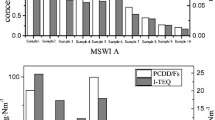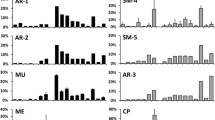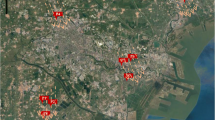Abstract
Distribution of polychlorinated dibenzo-p-dioxins and furans (PCDD/Fs) in the fly ash and atmospheric air of one medical waste incinerator (MWI) and one industrial hazardous waste incinerator (IHWI) plants were characterized. The PCDD/F concentrations of the stack gas (fly ash) produced from MWI and IHWI were 17.7 and 0.7 ng international toxic equivalent (I-TEQ)/Nm3 (4.1 and 2.5 ng I-TEQ/g), respectively. For workplace air, the total concentrations of PCDD/Fs were 11.32 and 0.28 pg I-TEQ/Nm3 (819.5 and 15.3 pg/Nm3). We assumed that the large differences of PCDD/F concentrations in workplace air were due to the differences in chlorine content of the waste, combustion conditions, and other contamination sources. With respect to the homologue profiles, the concentrations of PCDFs decreased with the increase of the substituted chlorine number for each site. Among all of the PCDD/F congeners, 2,3,4,7,8-PeCDF was the most important contributor to the I-TEQ value accounting for ca. 43 % of two sites. The gas/particle partition of PCDD/Fs in the atmosphere of the workplace in the MWI was also investigated, indicating that PCDD/Fs were more associated in the particle phase, especially for the higher chlorinated ones. Moreover, the ratio of the I-TEQ values in particle and gas phase of workplace air was 11.0. At last, the relationship between the distribution of PCDD/Fs in the workplace air and that from stack gas and fly ash was also analyzed and discussed. The high correlation coefficient might be a sign for diffuse gas emissions at transient periods of fumes escaping from the incinerator.




Similar content being viewed by others
References
Bhavsar SP, Reiner EJ, Hayton A, Fletcher R, MacPherson K (2008) Converting toxic equivalents (TEQ) of dioxins and dioxin-like compounds in fish from one toxic equivalency factor (TEF) scheme to another. Environ Int 34:915–921
Caserini S, Cernuschi S, Giugliano M, Grosso M, Lonati G, Mattaini P (2004) Air and soil dioxin levels at three sites in Italy in proximity to MSW incineration plants. Chemosphere 54:1279–1287
Chen S-J, Lee W-S, Chang-Chien G-P, Wang L-C, Lee W-J, Kao J-H, Hu M-T (2004) Characterizing polychlorinated dibenzo-p-dioxins and dibenzofurans in the surrounding environment and workplace of a secondary aluminum smelter. Atmos Environ 38:3729–3732
Chen T et al (2008) Characteristic of polychlorinated dibenzo-p-dioxins and dibenzofurans in fly ash from incinerators in china. J Hazard Mater 150:510–514
Cheng P-S, Hsu M-S, Ma E, Chou U, Ling Y-C (2003) Levels of PCDD/Fs in ambient air and soil in the vicinity of a municipal solid waste incinerator in Hsinchu. Chemosphere 52:1389–1396
Cobo M, Gálvez A, Conesa JA, Montes de Correa C (2009) Characterization of fly ash from a hazardous waste incinerator in Medellin, Colombia. J Hazard Mater 168:1223–1232
Directive EWI (2000) Directive 2000/76/EC of the European Parliament and of the Council on Incineration of Waste European Commission, Brussels
Duan H, Huang Q, Wang Q, Zhou B, Li J (2008) Hazardous waste generation and management in China: a review. J Hazard Mater 158:221–227
Fiedler H, Lau C, Eduljee G (2000) Statistical analysis of patterns of PCDDs and PCDFs in stack emission samples and identification of a marker congener. Waste Manag Res 18:283–292
Gao H et al (2009) Stack gas emissions of PCDD/Fs from hospital waste incinerators in China. Chemosphere 77:634–639
Grochowalski A (1998) PCDDs and PCDFs concentration in combustion gases and bottom ash from incineration of hospital wastes in Poland. Chemosphere 37:2279–2291
Hoyos A, Cobo M, Aristizábal B, Córdoba F, Montes de Correa C (2008) Total suspended particulate (TSP), polychlorinated dibenzodioxin (PCDD) and polychlorinated dibenzofuran (PCDF) emissions from medical waste incinerators in Antioquia, Colombia. Chemosphere 73:S137–S142
Hu S-W, ChangChien G-P, Chan C-C (2004) PCDD/Fs levels in indoor environments and blood of workers of three municipal waste incinerators in Taiwan. Chemosphere 55:611–620
Kadowaki S, Naitoh H (2005) Gas–particle partitioning of PCDD/Fs in Nagoya urban air, Japan. Chemosphere 59:1439–1453
Khumsaeng T, Kim Oanh NT, Kare KH, Polprasert C (2013) Emission of dioxins/furans and other U-POPs from test burns of non-POP pesticides in a hazardous waste incinerator. Waste Manag 33:833–841
Kim Y, Yang SH, Kim M, Shin DC (2001) PCDD and PCDF exposures in workers and controls living near an industrial waste incinerator. Chemosphere 43:985–987
Kim B-H, Lee S-J, Mun S-J, Chang Y-S (2005) A case study of dioxin monitoring in and around an industrial waste incinerator in Korea. Chemosphere 58:1589–1599
Kumagai S, Koda S, Miyakita T, Ueno M (2002) Polychlorinated dibenzo-p-dioxin and dibenzofuran concentrations in serum samples of workers at intermittently burning municipal waste incinerators in Japan. Occup Environ Med 59:362–368
Lee W-S, Chang-Chien G-P, Wang L-C, Lee W-J, Tsai P-J, Chen C-K (2003) Emissions of polychlorinated dibenzo-p-dioxins and dibenzofurans from the incinerations of both medical and municipal solid wastes. Aerosol Air Qual Res 3:1–6
Lee S-J, Choi S-D, Jin G-Z, Oh J-E, Chang Y-S, Shin SK (2007) Assessment of PCDD/F risk after implementation of emission reduction at a MSWI. Chemosphere 68:856–863
Li Y, Jiang G, Wang Y, Cai Z, Zhang Q (2008) Concentrations, profiles and gas–particle partitioning of polychlorinated dibenzo-p-dioxins and dibenzofurans in the ambient air of Beijing, China. Atmos Environ 42:2037–2047
Lin X et al (2013) Removal of PCDD/Fs and PCBs from flue gas using a pilot gas cleaning system. J Environ Sci 25:1833–1840
Lin X et al (2014) PCDD/F and PCBz Emissions during Start-up and Normal Operation of a Hazardous Waste Incinerator in China. Aerosol Air Qual Res 14:1142–1151
Liu H, Zhang Q, Cai Z, Li A, Wang Y, Jiang G (2006) Separation of polybrominated diphenyl ethers, polychlorinated biphenyls, polychlorinated dibenzo-p-dioxins and dibenzo-furans in environmental samples using silica gel and florisil fractionation chromatography. Anal Chim Acta 557:314–320
Mari M, Borrajo MA, Schuhmacher M, Domingo JL (2007) Monitoring PCDD/Fs and other organic substances in workers of a hazardous waste incinerator: a case study. Chemosphere 67:574–581
Mari M, Nadal M, Schuhmacher M, Domingo JL (2008) Monitoring PCDD/Fs, PCBs and metals in the ambient air of an industrial area of Catalonia, Spain. Chemosphere 73:990–998
Mari M, Nadal M, Schuhmacher M, Domingo JL (2009) Exposure to heavy metals and PCDD/Fs by the population living in the vicinity of a hazardous waste landfill in Catalonia, Spain: health risk assessment. Environ Int 35:1034–1039
National Bureau of Statistics of China (2002) China statistical yearbook. China Statistics Press, Beijing, pp 785–788
National Bureau of Statistics of China (2012) China statistical yearbook. China Statistics Press, Beijing, pp 431–433
NIP (China National Implementation Plan) (2007) China National Implementation Plan for the Stockholm Convention on Persistent Organic Pollutants. April 2007. <http://www.pops.int>
Oh J-E, Choi S-D, Lee S-J, Chang Y-S (2006) Influence of a municipal solid waste incinerator on ambient air and soil PCDD/Fs levels. Chemosphere 64:579–587
Pan Y et al (2013) Characteristics of dioxins content in fly ash from municipal solid waste incinerators in China. Chemosphere 92:765–771
Shih M, Lee W-J, Shih T-S, Huang S-L, Chang-Chien G-P, Wang L-C, Tsai P-J (2006a) Characterization of dibenzo-p-dioxins and dibenzofurans (PCDD/Fs) in the atmosphere of different workplaces of a sinter plant. Sci Total Environ 366:197–205
Shih S-I, Wang Y-F, Chang J-E, Jang J-S, Kuo F-L, Wang L-C, Chang-Chien G-P (2006b) Comparisons of levels of polychlorinated dibenzo-p-dioxins/dibenzofurans in the surrounding environment and workplace of two municipal solid waste incinerators. J Hazard Mater 137:1817–1830
Sonnenberg LB, Nichols KM (1995) Emissions of hydrochloric acid, PCDD and PCDF from the combustion of chlorine-containing kraft pulp mill bleach plant waste. Chemosphere 31:4207–4223
Tabata M, Ghaffar A, Shono A, Notomi K (2013) Hydrodechlorination/detoxification of PCDDs, PCDFs, and co-PCBs in fly ash by using calcium polysulfide. Waste Manag 33:356–362
US EPA (1994) Method 1613. Revision B: tetra- through octa-chlorinated dioxins and furans by isotope dilution HRGC/HRMS
US EPA (1995) Method 23. Determination of polychlorinated dibenzo-p-dioxins and polychlorinated dibenzofurans from municipal waste combustors. U.S. EPA, Washington, DC
US EPA (1999) TO-9A. Compendium Method TO-9A—determination of polychlorinated, polybrominated and brominated/chlorinated dibenzo-p-dioxins and dibenzofurans in ambient air, in Compendium of Methods for the Determination of Toxic Organic Compounds in Ambient Air, 2nd ed. Office of Research and Development, EPA/625/R-96/010b, January 1999, in Air Toxic Methods
Wang L-C et al (2003) Effect of chlorine content in feeding wastes of incineration on the emission of polychlorinated dibenzo-p-dioxins/dibenzofurans. Sci Total Environ 302:185–198
Wang M-S et al (2010) Determination of levels of persistent organic pollutants (PCDD/Fs, PBDD/Fs, PBDEs, PCBs, and PBBs) in atmosphere near a municipal solid waste incinerator. Chemosphere 80:1220–1226
Xu M-X et al (2009a) Concentrations, profiles, and sources of atmospheric PCDD/Fs near a municipal solid waste incinerator in eastern China. Environ Sci Technol 43:1023–1029
Xu M-X et al (2009b) Gas/particle partitioning of atmospheric PCDD/Fs in a satellite town in eastern China. Chemosphere 76:1540–1549
Yan J et al (2008) PCDD/F concentrations of agricultural soil in the vicinity of fluidized bed incinerators of co-firing MSW with coal in Hangzhou, China. J Hazard Mater 151:522–530
Zhu J, Hirai Y, Yu G, Sakai S-I (2008) Levels of polychlorinated dibenzo-p-dioxins and dibenzofurans in China and chemometric analysis of potential emission sources. Chemosphere 70:703–711
Acknowledgments
Financial support by the National High Technology Research and Development Key Program of China (no. 2012AA062803), the Major State Basic Research Development Program of China (973 Program) (no. 2011CB201500), and the Fundamental Research Funds for the Central Universities (no. 2012QNA4009)
Author information
Authors and Affiliations
Corresponding author
Additional information
Responsible editor: Ester Heath
Rights and permissions
About this article
Cite this article
Chen, T., Zhan, Mx., Lin, Xq. et al. Distribution of PCDD/Fs in the fly ash and atmospheric air of two typical hazardous waste incinerators in eastern China. Environ Sci Pollut Res 22, 1207–1214 (2015). https://doi.org/10.1007/s11356-014-3401-y
Received:
Accepted:
Published:
Issue Date:
DOI: https://doi.org/10.1007/s11356-014-3401-y




